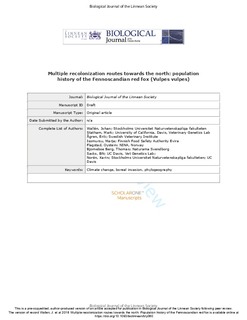| dc.contributor.author | Wallen, Johan | |
| dc.contributor.author | Statham, Mark J. | |
| dc.contributor.author | Ågren, Eirik | |
| dc.contributor.author | Isomursu, Marja | |
| dc.contributor.author | Flagstad, Øystein | |
| dc.contributor.author | Bjørneboe-Berg, Thomas | |
| dc.contributor.author | Sacks, Benjamin N. | |
| dc.contributor.author | Norén, Karin | |
| dc.coverage.spatial | Fennoscandia | nb_NO |
| dc.date.accessioned | 2019-07-11T10:42:18Z | |
| dc.date.available | 2019-07-11T10:42:18Z | |
| dc.date.created | 2019-01-24T12:42:36Z | |
| dc.date.issued | 2018 | |
| dc.identifier.citation | Biological Journal of the Linnean Society. 2018, 124 (4), 621-632. | nb_NO |
| dc.identifier.issn | 0024-4066 | |
| dc.identifier.uri | http://hdl.handle.net/11250/2604942 | |
| dc.description.abstract | Understanding the response of boreal species to past climate warming can help to predict future responses to climate change. In the Northern Hemisphere, the distribution and abundance of northern populations have been influenced by previous glaciations. In this study, we investigated the population history of the Fennoscandian red fox (Vulpes vulpes), which is a generalist carnivore currently undergoing range expansion in the tundra ecosystem. By analysing a 696 bp sequence of the mitochondrial DNA (N = 259) and two Y chromosome-specific microsatellite loci (N = 120), we specifically investigated where the red fox survived the Last Glacial Maximum and how Fennoscandia was recolonized. There was high genetic continuity across most of Fennoscandia, and we identified at least two recolonization pathways: one from continental Europe and one from the northeast (Siberia). Mitochondrial haplotype diversity displayed a significant decline with increasing latitude, consistent with expectations of unidirectional colonization. Each region displayed signatures of recent demographic and/or range expansions. For Finland, an additional recolonization route was suggested from the mismatch distribution analysis and identification of novel haplotypes. We concluded that, as with many boreal generalist species, the Fennoscandian red fox originates from multiple refugia, suggesting that it has benefited from diverse evolutionary histories, potentially enhancing its tolerance to different habitat conditions. | nb_NO |
| dc.language.iso | eng | nb_NO |
| dc.subject | boreal invasion | nb_NO |
| dc.subject | climate change | nb_NO |
| dc.subject | phylogeography | nb_NO |
| dc.title | Multiple recolonization routes towards the north: Population history of the Fennoscandian red fox (Vulpes vulpes) | nb_NO |
| dc.type | Journal article | nb_NO |
| dc.type | Peer reviewed | nb_NO |
| dc.description.version | acceptedVersion | nb_NO |
| dc.subject.nsi | VDP::Matematikk og Naturvitenskap: 400::Zoologiske og botaniske fag: 480 | nb_NO |
| dc.source.pagenumber | 621-632 | nb_NO |
| dc.source.volume | 124 | nb_NO |
| dc.source.journal | Biological Journal of the Linnean Society | nb_NO |
| dc.source.issue | 4 | nb_NO |
| dc.identifier.doi | 10.1093/biolinnean/bly060 | |
| dc.identifier.cristin | 1664371 | |
| cristin.unitcode | 7511,2,0,0 | |
| cristin.unitname | Avdeling for terrestrisk økologi | |
| cristin.ispublished | true | |
| cristin.fulltext | postprint | |
| cristin.qualitycode | 1 | |
